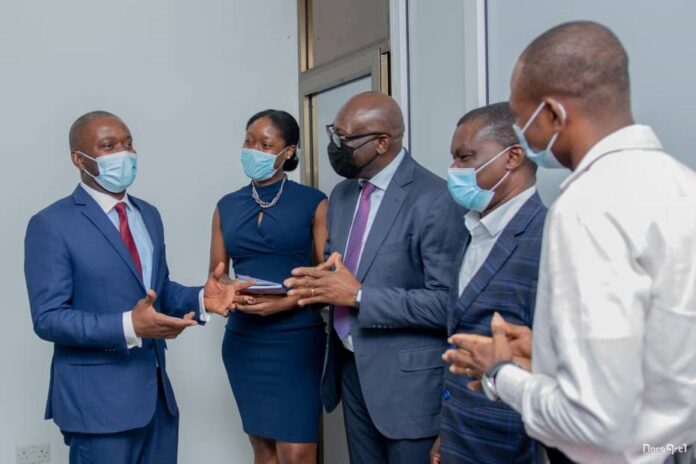
- …with establishment of Inter-Agency Framework and Task Force
Royalty payments due government from non-gold minerals such as Manganese, Salt, Limestone and Quarrying activities are set for an upturn, due to an Inter-Agency collaboration framework and Task Force initiated by the Minerals Income Investment Fund (MIIF).
The framework is part of a strategic thrust of MIIF to enhance collection of royalties, expand the royalties net and streamline communication on royalties’ payments from non-gold mining companies. The collaboration was initiated in December 2021 and has improved efficiency in collections by Ghana Revenue Authority (GRA), which is responsible for the collection of royalties on behalf of the MIIF; the Ghana Standards Authority (GSA) that assesses standards and accurate production measurements of minerals; and the Minerals Commission (MINCOM), regulator of the mining sector.
Prior to establishment of the inter-agency framework arrangement, operators in Quarrying, Limestone, Salt and Sand-winning activities either did not honour payments or underpaid their royalties. Mineral royalties are payments made by all mining companies to the Government of Ghana through MIIF for the right to continuous production from a particular mine. In Ghana, royalties are typically agreed as a percentage of gross or net production of every mineral – including salt, limestone, sand-winning and quarrying activities.
The Chief Executive Officer of MIIF, Edward Nana Yaw Koranteng, told journalists in Accra: “I am supremely confident that we will see an upturn in royalties for Ghana from non-gold producers by end of the year 2022. The gold sector, which constitutes about 92% of the mineral royalties, is also expected to see production increase with new mines coming on board this year – supported by a rise in gold price on the back of global economic uncertainty, a seeming weaker US dollar and increased geopolitical tensions highlighted by the Russia-Ukraine war.
“We expect new manganese mines to be announced soon, as well as additional discoveries of Barite and Lithium. My optimism is however premised on the measures we have taken with this inter-agency collaboration which includes an inter-agency task force for non-gold minerals that could see royalties from activities such as quarrying, limestone and sand-winning going up by over 100%, for each stream in 2022.”
Edward Koranteng expressed his profound gratitude to the Chief Executives of MINCOM and GSA – Martin Kwaku Ayisi and Prof Alex Doudou respectively, as well as the Commissioner General of GRA, Rev Dr. Ammishadai, for agreeing to collaborate with MIIF on this initiative.
He added: “Since the initiative started in December 2021, MIIF for the first time in its two-year history has started receiving royalties from sand-winners. Royalties from quarries and limestone activities have surged 105% and 125% respectively, year to date. There is still a huge gap between the actual and the potential when it comes to royalties from the above stated minerals, but we intend to intensify our efforts under this initiative.
“I am pleased to announce that the Minerals Development Fund (MDF) will soon be added to this interagency mechanism to give us a holistic view of the royalties’ landscape including outflows for the benefit of mining communities and Ghana as a whole.”
Edward Nana Yaw Koranteng further added: “The quarry sector, for example, should be giving Ghana at least GH¢50million a year but only brought in GH¢3.8million in 2020. The salt sector can also be developed to increase royalties exponentially, while Silver also has the potential to surge due to its correlation with gold production. Such underpayments are what the Inter Agency Collaboration seeks to arrest,” said Edward Koranteng.
The Chairman of the Inter-Agency committee, Francis Appiah- Amoh of the GRA, told journalists: “We are learning a lot just by sitting in the same room and sharing our processes. We have realised there are many areas where we are better working together. We are sure by the time we go into full implementation of our report, payment of royalties will be easier, faster and more transparent for everyone. Another positive effect we see is that operators in the non-gold sector will become more efficient in their operations. We are not only after payments. We are also seeking to help them become more productive”.
For Edward Koranteng, the objectives of MIIF in this strategic collaboration are clear. “We have to actualise the president’s vision of guaranteeing the future wealth of Ghanaians through MIIF. We are doing this by investing our mineral wealth in profitable asset classes that will yield dividends for future generations.” Mr. Koranteng added that MIIF, which recently purchased an equity stake in Toronto and Frankfurt-listed Asante Gold Corporation, also seeks to invest heavily in the small-scale mining sector.
He said: “We intend to invest up to US$500million in the sector over the next seven to ten years, through collaborative foreign direct investments and guaranteed offtake arrangements for small-scale miners under an initiative called the MIIF Small-Scale Mining Incubation Programme”. According to the CEO, this programme has the added objective of promoting environmentally sustainable mining; formalising the small-scale mining sector, thereby improving revenue generation; and assisting Ghanaians attain the ‘commanding heights’ of the minerals sector” Edward Koranteng concluded.









